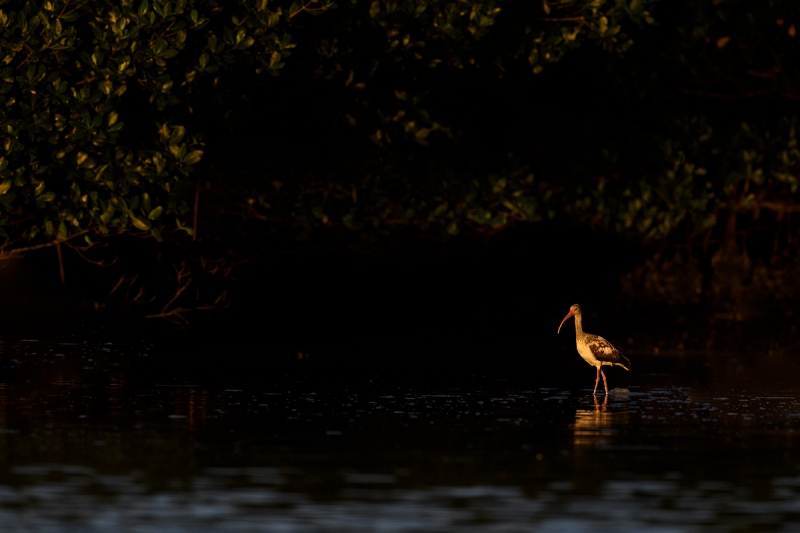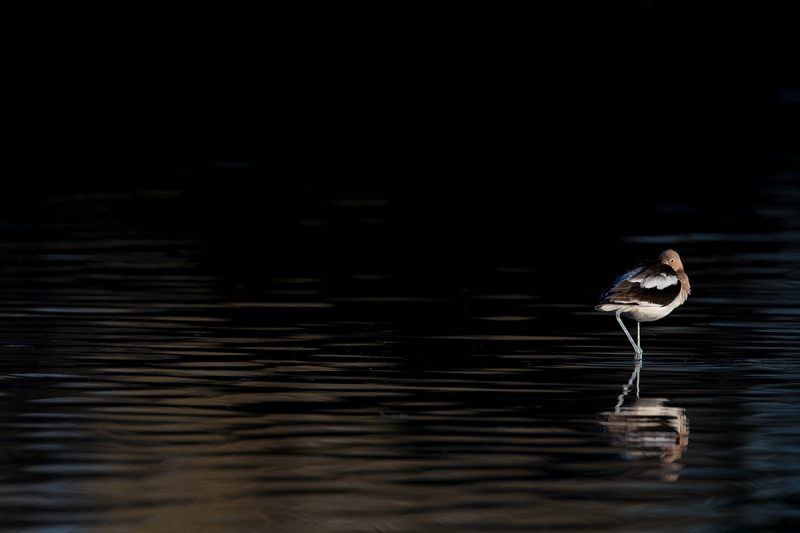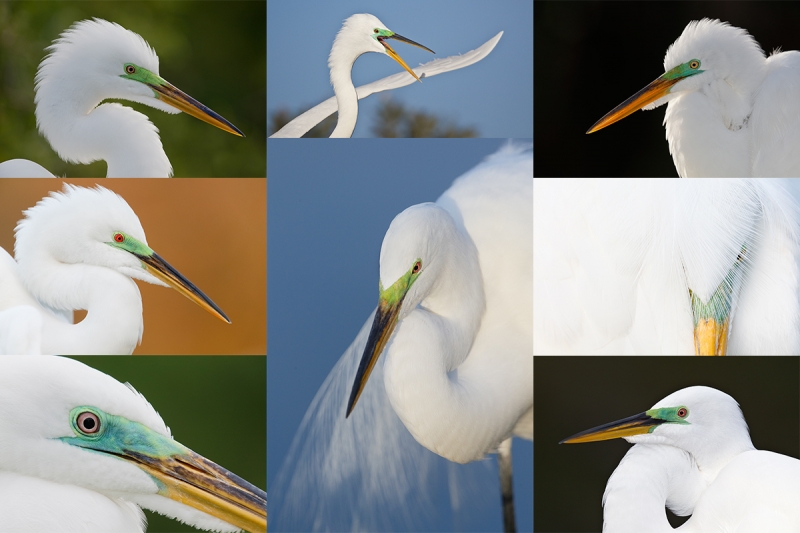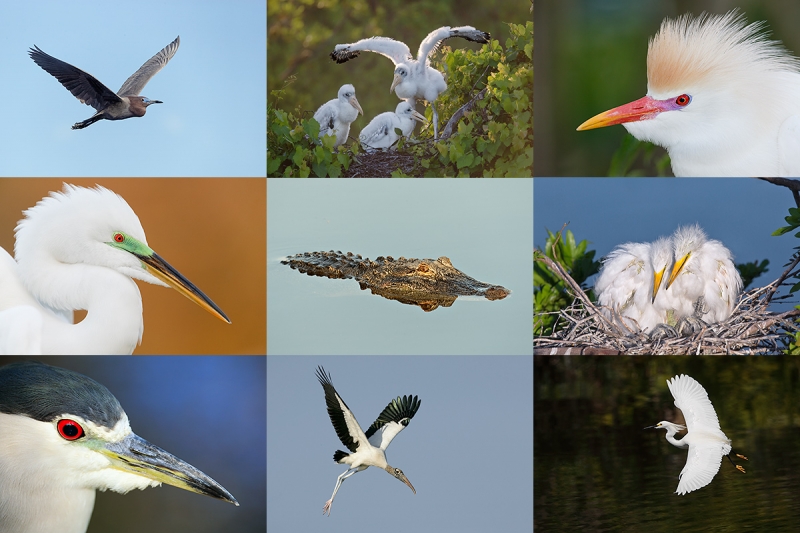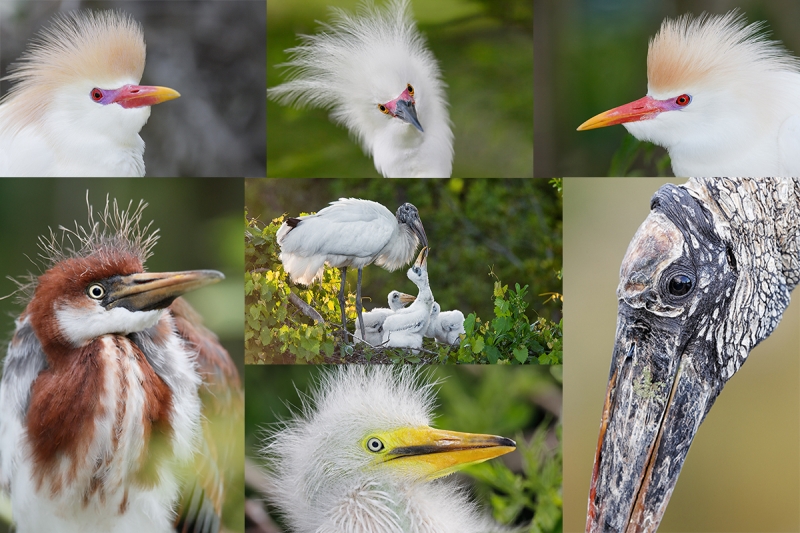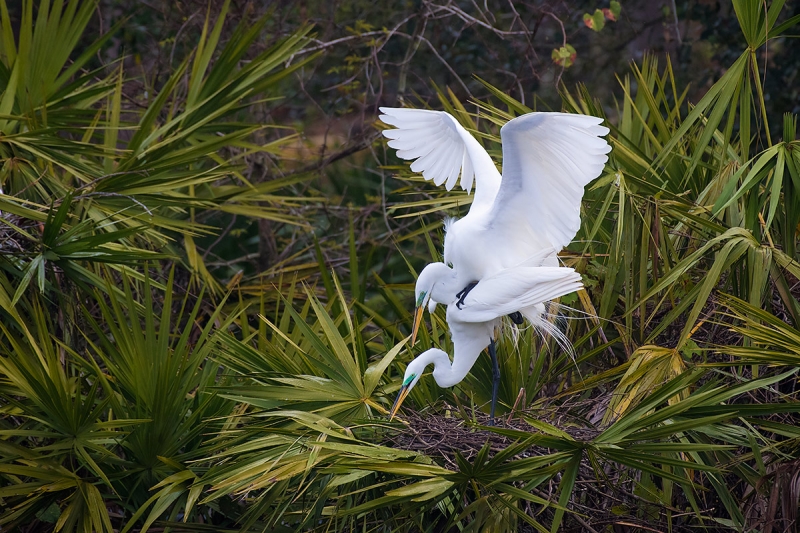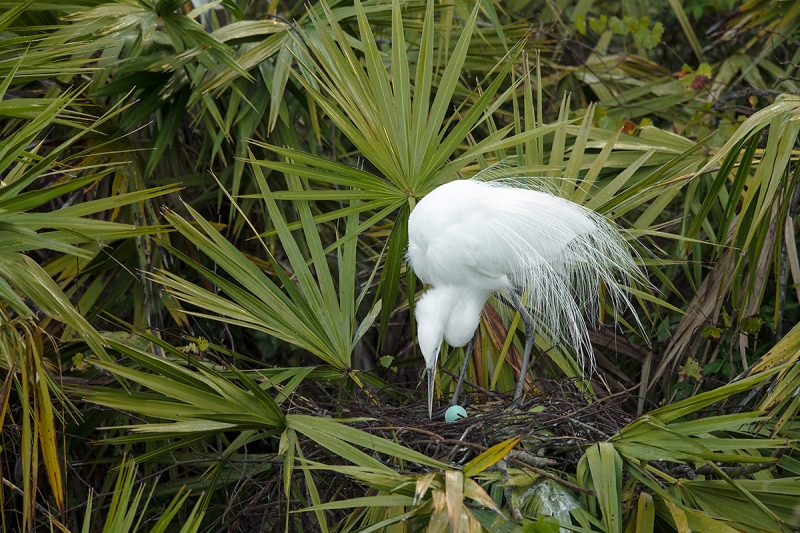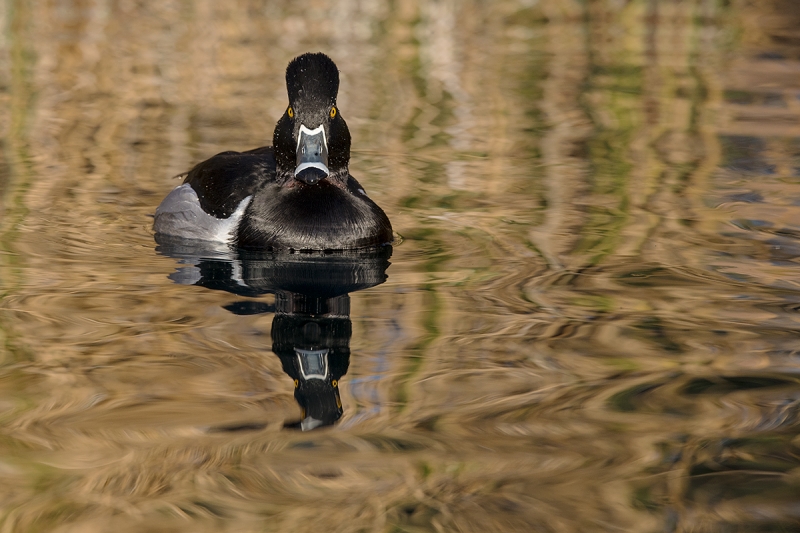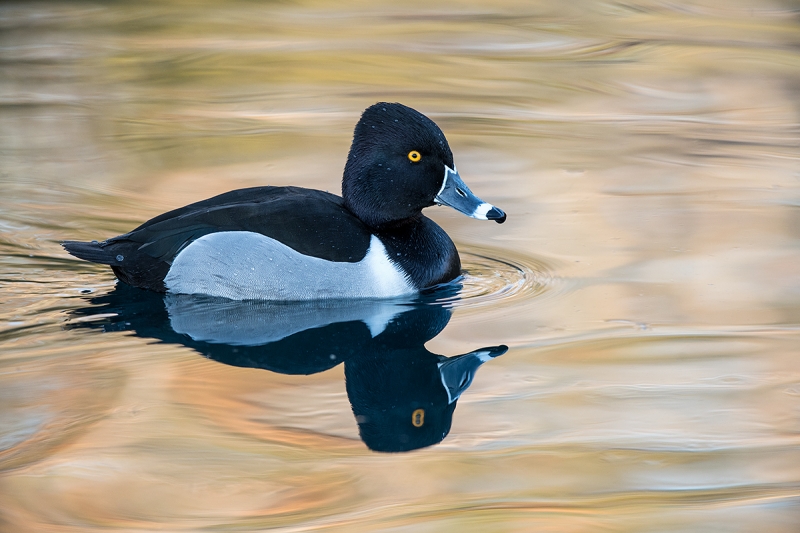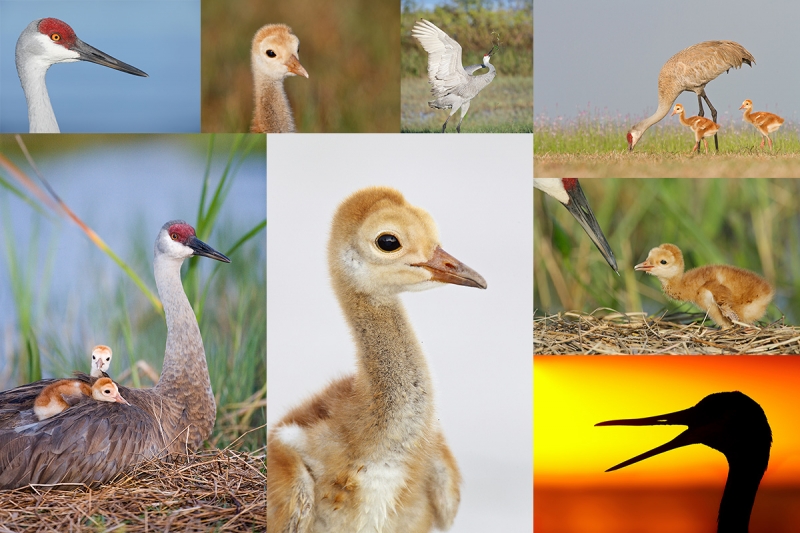March 5th, 2018 Stuff
Sunday morning at Gilbert was definitively not as productive as Saturday which had been poor at best. Again we met up with physiotherapist Amy Novotny and friend Bryan Holliday. They added lots of water to my favorite pond and thus, there were no birds there at all.
The Streak
Today makes two hundred seventeen days in a row with a new educational blog post! This one took about 40 minutes to prepare. With all of my upcoming free time (or not…), the plan right now is to break the current record streak of 480 … Good health and good internet connections and my continuing insanity willing.
Exposure Math Answer
In the Sun or Shade? And Another Exposure Math Quiz blog post here, I asked that folks calculate the difference in the exposure for Image #1 and Image #2.
Image #1 was created at ISO 400. 1/1000 sec. at f/7.1.
Image #2 was created at ISO 800. 1/160 sec. at f/6.3.
From ISO 400 yo ISO 800 is one stop.
From 1 1/1000 sec. down to 1/160 sec. goes like this: 1/160 … 1/320 …1/640 is two full stops. From 1/640 sec. to 1/1000 sec is another 2/3 stop. So 2 2/3stops in all. From f/7.1 to f/6.3 is 1/3 stop. All in the same direction. So in total the difference in exposure was exactly four full stops: 1 + 2 2/3 + 1/3 = 4.
Keith Swindell was the first to answer correctly when he wrote at 9:44am on March 3: Looks to be 4 stops to me (ISO: 1 stop, Tv: 2 1/3 stops, Av: 2/3 stop).
And like me, he preferred the second image, the one in the shade:
I prefer the shot in the shade, birds from directly head-on look awkward to me.
While I do like both images, I absolutely love the watercolor look of the second image, the one made in the shade. That in part because of the greatly reduced contrast.
The Used Gear Page
Action on the Used Gear Page recently has been fantastic. You can see all current listings on the Used Photo Gear page here.
Booking.Com
Several folks on the Spoonbill IPTs used the Booking.Com link below and got great rates and saved a handsome $25.00 in the process. If you too would like to give Booking.Com a shot, click here and to earn a $25 reward on your first booking. Thanks to the many who have already tried and used this great service.
Gear Questions and Advice
Too many folks attending BAA IPTs and dozens of folks whom I see in the field, and on BPN, are–out of ignorance–using the wrong gear especially when it comes to tripods and more especially, tripod heads… Please know that I am always glad to answer your gear questions via e-mail. Those questions might deal with systems, camera bodies, accessories, and/or lens choices and decisions.
No More Rear Button Focus
I no longer use rear button focus. I tried to figure out how to set that up with my Nikon gear but could not. Instead, I programed the AF-ON button to lock AF; you need to press and hold the button down. It works like a charm when you are on a tripod and it is even better when the bird is standing stock still as in Image #1 or is sleeping as in Image #2.
|
|
|
This image was created at the Gilbert Water Ranch Riparian Preserve on the morning of March 3, 2018 with the Induro GIT 304L/Mongoose M3.6-mounted Nikon AF-S NIKKOR 600mm f/4E FL ED VR lens, the Nikon AF-S Teleconverter TC-14E III, and the Nikon D850. ISO 400. Matrix metering -2 stops: 1/2500 sec. at f/7.1. AUTO0 WB at 7:35am.
Center d-9 shutter Button AF. Focused on the bird, locked focus by holding the he AF-ON button, and recomposed.
Nikon Focus peaking AF Fine-tune: +5. (Please see and carefully read Nikon Focus Fine-tune Guide item below). Click on the image to see a larger version.
Image #2: American Avocet, sidelit in black water
|
Multiple Choice Image Preference Question
Which image is the strongest”
- a-Image #1. Please let us know why you made your choice.
- b-Image #2. Please let us know why you made your choice.
- c-I like them both. Please let us know why.
- d-I do not like either image. Please let us know why.
Light Angle Notes …
Note that in Image #1 my shadow was pretty much pointed right at the bird. I was working on sun angle as I almost always do. With Image #2 I was about 45 degrees off sun angle; the subject was very strongly sidelit. But as the subject was angled about 45 degrees away from me the half of the bird that we see was pretty much directly lit. It is very rarely that I work with side light.
Please Note
I have been getting lots of e-mails below on qualifying for a free Nikon D850/D5 Focus Fine-tune Guide (should I ever actually get started on and finish it). “I once met you in San Diego; do I qualify for a free guide? I bought your micro-adjusting guide; do I get a free copy of the Nikon D850/D5 Focus Fine-tune Guide? Please read the item below before e-mailing as it clearly states the qualifications for getting the guide for free 🙂
The Nikon D850/D5 Focus Fine-tune Guide
I hope to be working on a Nikon D850/D5 Focus Fine-tune Guide while I am in Phoenix. There is lots of mis-information out there on Nikon Automatic AF Fine-tune. Working with Patrick Sparkman, we perfected a method of using the Focus Peaking feature available only on the D850 to quickly and accurately micro-adjust all of your lenses and TC-Es with your D-850. Both Nikon Automatic AF Fine-tune and D850 Focus Peaking AF Fine-tune require a LensAlign Mark II kit. If you know for sure whether the very popular Nikon D500 DSLR Camera (Body Only) (or any other of the newer Nikon dSLRs) offer Automatic AF Fine-tune.
Folks who purchase a Nikon D850, a Nikon D5 DSLR Camera (Body Only, Dual XQD Slots), or any Nikon gear totaling more than $2,000 will receive the new guide free. I hope to have it finished in three weeks but don’t hold me to it 🙂
Registering for an IPT
To register for any of the IPTs below call Jim or Jen in the office at 863-692-0906 from Monday morning through Friday lunch with your credit card in hand to leave your $500 non-refundable deposit. Balances may not be paid by credit card so you will be asked to send a check for your balance along with the signed paperwork that you will find here.
|
|
Great Egrets in breeding plumage are quite beautiful
|
Gatorland IPT #1. Sunrise: 7:25am, Sunset: 7:40pm
3 1/2 DAYs: THURS 22 March through and including the morning of SUN 25 MAR. $1599. Limit 5 photographers.
(2 1/2 DAY option) FRI 23 March through and including the morning of SUN 25 MAR. $1199.
Must purchase Gatorland Photographers Pass. Click here for details. All early entry. Late stays Friday and Saturday. Thursday late-stay is under discussion. Gatorland IPT #1 is best for killer breeding plumage Great Egrets. With chicks. Also Wood Stork and Cattle Egret. Surprisingly, there are already more than a few Snowy Egrets and Tricolored Herons in breeding plumage! Learn to get the right exposure, flight photography techniques, my secret Gatorland spots, how to see the best situations (nobody is better at that than me), and how to make great images in extremely cluttered situations.
|
|
Tame birds in breeding plumage are great fun.
|
Gatorland IPT #2. Sunrise: 6:48am. Sunset: 7:58pm.
3 1/2 DAYs: THURS 26 APR through and including the morning of SUN 29 APR. $1599. Limit 5 photographers.
(2 1/2 DAY option) FRI 27 APR through and including the morning of SUN 29 APR. $1199.
Must purchase Gatorland Photographers Pass. Click here for details. All early entry. Late stays Friday and Saturday. Thursday late-stay is under discussion. Gatorland IPT #2 should have lots of chicks, and lots of birds in breeding plumage. We will get to photograph Great Egret, Snowy Egret, Tricolored Heron, and Wood Stork. The Cattle Egrets in full breeding plumage will be present in good numbers. Learn my Gatorland strategy, to get the right exposure, flight photography techniques, my secret Gatorland spots, how to see the best situations (nobody is better at that than me), and how to make great images in extremely cluttered situations.
|
|
Large Tricolored Heron chicks (lower left) are to die for!
|
Gatorland #3. Sunrise: 6:33am. Sunset: 8:10pm.
3 1/2 DAYs: THURS 17 MAY through and including the morning of SUN 20 MAY. $1599. Limit 5 photographers.
(2 1/2 DAY option) FRI 18 MAY through and including the morning of SUN 20 MAY. $1199.
Must purchase Gatorland Photographers Pass. Click here for details. All early entry. Late stays Friday and Saturday. Thursday late-stay is under discussion. Gatorland IPT #3 is best for medium sized chicks of the following species: Cattle Egret, Snowy Egret, and Tricolored Heron. Head portraits of handsome fledged Great Egrets are pretty much guaranteed. Learn to get the right exposure, flight photography techniques, my secret Gatorland spots, how to see the best situations (nobody is better at that than me), and how to make great images in extremely cluttered situations.
Help Support the Blog
Please help support my (stupendous) efforts here on the blog by remembering to click on the logo link above each time that you shop Amazon. That would be greatly appreciated. There is no problem using your Prime account; just click on the link and log into your Prime account. With love, artie
If In Doubt …
If in doubt about using the BAA B&H affiliate link correctly, you can always start your search by clicking here. Please note that the tracking is invisible. Web orders only. Please, however, remember to shoot me your receipt via e-mail.




Please Remember to use my Affiliate Links and to Visit the New BAA Online Store 🙂
To show your appreciation for my continuing efforts here, we ask, as always, that you get in the habit of using my B&H affiliate links on the right side of the blog for all of your photo and electronics purchases. Please check the availability of all photographic accessories in the New BIRDS AS ART Online Store, especially the Mongoose M3.6 tripod head, Wimberley lens plates, Delkin flash cards and accessories, and LensCoat stuff.
As always, we sell only what I have used, have tested, and can depend on. We will not sell you junk. We know what you need to make creating great images easy and fun. And please remember that I am always glad to answer your gear questions via e-mail.
I would of course appreciate your using our B&H affiliate links for all of your major gear, video, and electronic purchases. For the photographic stuff mentioned in the paragraph above, and for everything else in the new store, we, meaning BAA, would of course greatly appreciate your business. Here is a huge thank you to the many who have been using our links on a regular basis and those who will be visiting the New BIRDS AS ART Online Store as well.
Facebook
Be sure to like and follow BAA on Facebook by clicking on the logo link upper right. Tanks a stack.
Typos
In all blog posts and Bulletins, feel free to e-mail or to leave a comment regarding any typos or errors. Just be right :).
March 4th, 2018 Stuff
Saturday morning was pretty poor at best. We met up with physiotherapist Amy Novotny and friends Bryan Holliday and Kim at Gilbert. They added lots of water to the best ponds … We did get some nice flight images of Ring-necked Ducks.
We had a great dinner at Rodizio Grill, The Brazilian Steakhouse in Mesa. We had a very nice chat with the general manager, the delightful and — at only 28 years old — amazingly polished, Shawna Fitzgerald.
The Streak
Today makes two hundred sixteen days in a row with a new educational blog post! This one took about 30 minutes to prepare. With all of my upcoming free time (or not…), the plan right now is to break the current record streak of 480 … Good health and good internet connections and my continuing insanity willing.
The Used Gear Page
Action on the Used Gear Page recently has been fantastic. You can see all current listings on the Used Photo Gear page here.
Booking.Com
Several folks on the Spoonbill IPTs used the Booking.Com link below and got great rates and saved a handsome $25.00 in the process. If you too would like to give Booking.Com a shot, click here and to earn a $25 reward on your first booking. Thanks to the many who have already tried and used this great service.
Gear Questions and Advice
Too many folks attending BAA IPTs and dozens of folks whom I see in the field, and on BPN, are–out of ignorance–using the wrong gear especially when it comes to tripods and more especially, tripod heads… Please know that I am always glad to answer your gear questions via e-mail. Those questions might deal with systems, camera bodies, accessories, and/or lens choices and decisions.
|
|
|
This image was created on February 17, 2018 at Gatorland with the Induro GIT 304L/Mongoose M3.6-mounted Nikon AF-S NIKKOR 200-500mm f/5.6E ED VR lens (at 500mm) and the mega mega-pixel Nikon D850 DSLR.. ISO 800. Matrix metering probably at +1/3 stop as originally framed: 1/1600 sec. at f/6.3 in Manual mode. WB: AUTO0 at 9:02am on a foggy morning.
Center Group/Shutter Button AF as originally framed; the diamond pattern was on the male’s shoulder. Click on the image to enjoy a larger version.
Image #1: Great Egret pair copulating at the nest
|
Image Design
Note that though I chose the center AF cluster that the bird is nicely back in the frame, that in part due to a crop from below and from our right. As I often do, I opted to maintain the 3X2 proportion of the original by hitting C for the Crop Tool, selecting 2X3, and then flopping that to 3X2 by hitting the two-way arrow.
New Policies, New Possibilities
The new early entry policy at Gatorland — now four days a week, and earlier entry times — opens up some great photographic possibilities for those who know where to be when. Join me at Gatorland to learn my early morning strategies and allow me to share the rest of my BIRDS AS ART Gatorland knowledge with you.
|
|
|
This image was created at Gatorland on the morning of February 22, 2018 with the Induro GIT 304L/Mongoose M3.6-mounted Nikon AF-S NIKKOR 600mm f/4E FL ED VR lens, the Nikon AF-S Teleconverter TC-14E III, and the Nikon D850. ISO 1250. Matrix metering +2/3 stop as originally framed: 1/500 sec. at f6.3. Cloudy WB at 7:28am in the shade.
Center Group (grp) shutter Button AF with the AF cluster centered on the bird’s neck.
AF Fine-tune: +5. (Please see and carefully read Nikon Focus Fine-tune Guide item below). Click on the image to see a larger version.
Image #2: Great Egret with single egg in nest
|
Your Favorite?
Which of today’s two featured images do you like best? Be sure to let us know why. Again, I have a very clear favorite and will share it with you here soon along with my reasons.
Please Note
I have been getting lots of e-mails below on qualifying for a free Nikon D850/D5 Focus Fine-tune Guide (should I ever actually get started on and finish it). “I once met you in San Diego; do I qualify for a free guide? I bought your micro-adjusting guide; do I get a free copy of the Nikon D850/D5 Focus Fine-tune Guide? Please read the item below before e-mailing as it clearly states the qualifications for getting the guide for free 🙂
The Nikon D850/D5 Focus Fine-tune Guide
I hope to be working on a Nikon D850/D5 Focus Fine-tune Guide while I am in Phoenix. There is lots of mis-information out there on Nikon Automatic AF Fine-tune. Working with Patrick Sparkman, we perfected a method of using the Focus Peaking feature available only on the D850 to quickly and accurately micro-adjust all of your lenses and TC-Es with your D-850. Both Nikon Automatic AF Fine-tune and D850 Focus Peaking AF Fine-tune require a LensAlign Mark II kit. If you know for sure whether the very popular Nikon D500 DSLR Camera (Body Only) (or any other of the newer Nikon dSLRs) offer Automatic AF Fine-tune.
Folks who purchase a Nikon D850, a Nikon D5 DSLR Camera (Body Only, Dual XQD Slots), or any Nikon gear totaling more than $2,000 will receive the new guide free. I hope to have it finished in three weeks but don’t hold me to it 🙂
Registering for an IPT
To register for any of the IPTs below call Jim or Jen in the office at 863-692-0906 from Monday morning through Friday lunch with your credit card in hand to leave your $500 non-refundable deposit. Balances may not be paid by credit card so you will be asked to send a check for your balance along with the signed paperwork that you will find here.
|
|
Great Egrets in breeding plumage are quite beautiful
|
Gatorland IPT #1. Sunrise: 7:25am, Sunset: 7:40pm
3 1/2 DAYs: THURS 22 March through and including the morning of SUN 25 MAR. $1599. Limit 5 photographers.
(2 1/2 DAY option) FRI 23 March through and including the morning of SUN 25 MAR. $1199.
Must purchase Gatorland Photographers Pass. Click here for details. All early entry. Late stays Friday and Saturday. Thursday late-stay is under discussion. Gatorland IPT #1 is best for killer breeding plumage Great Egrets. With chicks. Also Wood Stork and Cattle Egret. Surprisingly, there are already more than a few Snowy Egrets and Tricolored Herons in breeding plumage! Learn to get the right exposure, flight photography techniques, my secret Gatorland spots, how to see the best situations (nobody is better at that than me), and how to make great images in extremely cluttered situations.
|
|
Tame birds in breeding plumage are great fun.
|
Gatorland IPT #2. Sunrise: 6:48am. Sunset: 7:58pm.
3 1/2 DAYs: THURS 26 APR through and including the morning of SUN 29 APR. $1599. Limit 5 photographers.
(2 1/2 DAY option) FRI 27 APR through and including the morning of SUN 29 APR. $1199.
Must purchase Gatorland Photographers Pass. Click here for details. All early entry. Late stays Friday and Saturday. Thursday late-stay is under discussion. Gatorland IPT #2 should have lots of chicks, and lots of birds in breeding plumage. We will get to photograph Great Egret, Snowy Egret, Tricolored Heron, and Wood Stork. The Cattle Egrets in full breeding plumage will be present in good numbers. Learn my Gatorland strategy, to get the right exposure, flight photography techniques, my secret Gatorland spots, how to see the best situations (nobody is better at that than me), and how to make great images in extremely cluttered situations.
|
|
Large Tricolored Heron chicks (lower left) are to die for!
|
Gatorland #3. Sunrise: 6:33am. Sunset: 8:10pm.
3 1/2 DAYs: THURS 17 MAY through and including the morning of SUN 20 MAY. $1599. Limit 5 photographers.
(2 1/2 DAY option) FRI 18 MAY through and including the morning of SUN 20 MAY. $1199.
Must purchase Gatorland Photographers Pass. Click here for details. All early entry. Late stays Friday and Saturday. Thursday late-stay is under discussion. Gatorland IPT #3 is best for medium sized chicks of the following species: Cattle Egret, Snowy Egret, and Tricolored Heron. Head portraits of handsome fledged Great Egrets are pretty much guaranteed. Learn to get the right exposure, flight photography techniques, my secret Gatorland spots, how to see the best situations (nobody is better at that than me), and how to make great images in extremely cluttered situations.
Help Support the Blog
Please help support my (stupendous) efforts here on the blog by remembering to click on the logo link above each time that you shop Amazon. That would be greatly appreciated. There is no problem using your Prime account; just click on the link and log into your Prime account. With love, artie
If In Doubt …
If in doubt about using the BAA B&H affiliate link correctly, you can always start your search by clicking here. Please note that the tracking is invisible. Web orders only. Please, however, remember to shoot me your receipt via e-mail.




Please Remember to use my Affiliate Links and to Visit the New BAA Online Store 🙂
To show your appreciation for my continuing efforts here, we ask, as always, that you get in the habit of using my B&H affiliate links on the right side of the blog for all of your photo and electronics purchases. Please check the availability of all photographic accessories in the New BIRDS AS ART Online Store, especially the Mongoose M3.6 tripod head, Wimberley lens plates, Delkin flash cards and accessories, and LensCoat stuff.
As always, we sell only what I have used, have tested, and can depend on. We will not sell you junk. We know what you need to make creating great images easy and fun. And please remember that I am always glad to answer your gear questions via e-mail.
I would of course appreciate your using our B&H affiliate links for all of your major gear, video, and electronic purchases. For the photographic stuff mentioned in the paragraph above, and for everything else in the new store, we, meaning BAA, would of course greatly appreciate your business. Here is a huge thank you to the many who have been using our links on a regular basis and those who will be visiting the New BIRDS AS ART Online Store as well.
Facebook
Be sure to like and follow BAA on Facebook by clicking on the logo link upper right. Tanks a stack.
Typos
In all blog posts and Bulletins, feel free to e-mail or to leave a comment regarding any typos or errors. Just be right :).
March 3rd, 2018 Stuff
On Friday there was a clear sunrise with zero wind and perfect reflections everywhere. Just not many close birds. So I experimented at 1200mm with my 600 f/4/TC-E20/D850 combo on sleeping avocets. I tried focusing with Live View, turning AF off, setting the 5-second timer, and pressing the shutter button. Then it was a too-long nap for me.
The Streak
Today makes two hundred fifteen days in a row with a new educational blog post! This one took about 30 minutes to prepare. With all of my upcoming free time (or not…), the plan right now is to break the current record streak of 480 … Good health and good internet connections and my continuing insanity willing.
The Used Gear Page
Action on the Used Gear Page recently has been fantastic. You can see all current listings on the Used Photo Gear page here.
Booking.Com
Several folks on the Spoonbill IPTs used the Booking.Com link below and got great rates and saved a handsome $25.00 in the process. If you too would like to give Booking.Com a shot, click here and to earn a $25 reward on your first booking. Thanks to the many who have already tried and used this great service.
Gear Questions and Advice
Too many folks attending BAA IPTs and dozens of folks whom I see in the field, and on BPN, are–out of ignorance–using the wrong gear especially when it comes to tripods and more especially, tripod heads… Please know that I am always glad to answer your gear questions via e-mail. Those questions might deal with systems, camera bodies, accessories, and/or lens choices and decisions.
|
|
|
This image was created on the afternoon of Thursday, March 2, 2018 at the Gilbert Water Ranch Riparian Preserve in Phoenix, AZ. I used the Induro GIT 304L/Mongoose M3.6-mounted Nikon AF-S NIKKOR 600mm f/4E FL ED VR lens, the Nikon AF-S Teleconverter TC-14E III, and the Nikon D850. ISO 400. Matrix metering -1 stop as originally framed: 1/1000 sec. at f/7.1 AWB (AUT02) at 5:40pm in very late afternoon sunlight.
Center d-9 upper shutter Button AF with the selected AF point was on the bird’s right upper breast on the same plane as the duck’s eye.
Focus Peaking micro-adjustment: +4. (Please see and carefully read Nikon Focus Fine-tune Guide item below). Click on the image to see a larger version.
Ring-necked Duck in late afternoon light
|
In the Sun
Of those created in the sun on Thursday afternoon, this was my favorite. We figured things out very late in the day. I am 100% positive that there are some spectacular images of ring-neckeds in the sun at this particular location. I just have not made them quite yet. Note the exposure compensation in the sun: -1 stop. Why was that much negative EC needed?
|
|
|
This image was also created on the afternoon of Thursday, March 2, 2018 at the Gilbert Water Ranch Riparian Preserve in Phoenix, AZ. I used the Induro GIT 304L/Mongoose M3.6-mounted Nikon AF-S NIKKOR 600mm f/4E FL ED VR lens, the Nikon AF-S Teleconverter TC-14E III, and the Nikon D850. ISO 800. Matrix metering 2/3 stop as framed: 1/160 sec. at f/6.3. AWB (AUTO2) at 6:03pm in the shade.
Center d-9 upper shutter Button AF; the selected AF point was on the base of the duck’s neck slightly behind but on the same plane as the its eye.
Focus Peaking micro-adjustment: +4. (Please see and carefully read Nikon Focus Fine-tune Guide item below). Click on the image to see a larger version.
Image #2: Ring-necked Duck in the shade
|
In the Shade
Once the sun dipped behind the trees and buildings to the west we were left to raise the ISO and work with slower shutter speeds. The Ring-necked Duck images took on a totally different look. Note the correct exposure compensation for Image #2: +2/3 stop. Compare that with the EC in Image #1 and see if you learn anything …
Your Favorite?
Which of today’s featured images do you like best? Be sure to let us know why. I have a very clear favorite and will share it with you here soon along with my reasons.
Another Exposure Math Quiz
How many stops different was the sun exposure (Image #1) from the shade exposure (Image #2)?
Please Note
I have been getting lots of e-mails below on qualifying for a free Nikon D850/D5 Focus Fine-tune Guide (should I ever actually get started on and finish it). “I once met you in San Diego; do I qualify for a free guide? I bought your micro-adjusting guide; do I get a free copy of the Nikon D850/D5 Focus Fine-tune Guide? Please read the item below before e-mailing as it clearly states the qualifications for getting the guide for free 🙂
The Nikon D850/D5 Focus Fine-tune Guide
I hope to be working on a Nikon D850/D5 Focus Fine-tune Guide while I am in Phoenix. There is lots of mis-information out there on Nikon Automatic AF Fine-tune. Working with Patrick Sparkman, we perfected a method of using the Focus Peaking feature available only on the D850 to quickly and accurately micro-adjust all of your lenses and TC-Es with your D-850. Both Nikon Automatic AF Fine-tune and D850 Focus Peaking AF Fine-tune require a LensAlign Mark II kit. If you know for sure whether the very popular Nikon D500 DSLR Camera (Body Only) (or any other of the newer Nikon dSLRs) offer Automatic AF Fine-tune.
Folks who purchase a Nikon D850, a Nikon D5 DSLR Camera (Body Only, Dual XQD Slots), or any Nikon gear totaling more than $2,000 will receive the new guide free. I hope to have it finished in three weeks but don’t hold me to it 🙂
|
|
Early Spring Photo Opportunities at ILE
|
BIRDS AS ART first-ever Master Classes
Master Class Session 1. Two Full and two Half Days/Friday afternoon, March 16 through lunch on Monday, March 19, 2018: course fee: $1,999. Limit: 4/openings:3
Master Class Session 2. Two Full and two Half Days/Friday afternoon, March 30 through lunch on Monday, April 2, 2018. Limit: 4/openings:3
The Master Classes will be small groups — strictly limited to four photographers — with the first folks who register having the option of staying at my home ($50/night) or at a chain motel in nearby Lake Wales. Live, think, and breathe photography from Friday afternoon through lunch on Monday (late-morning); all meals included. There will be three afternoon photo sessions (FRI – SUN) hopefully with glorious sunsets like the ones you saw one the blog in December we should have good opportunities with the cranes even in the afternoon. We will enjoy three morning photography sessions (SAT – MON) with the main subjects being tame Sandhill Cranes almost surely with chicks or colts. Also vultures and Cattle Egrets and more. Limpkins are possible. Intermediate telephoto lenses are fine for the cranes, even the chicks at times. A 500 or 600mm lens would be best for many of the situations that we will encounter.
During the day we will sit together around my dining room table and pick everyone’s keepers and enjoy guided Photoshop sessions. On Monday before lunch, folks can make a single large print of their favorite image from the weekend. If you so choose, I will micro-adjust one of your lenses (at one focal length with your #1 camera body–Canon or Nikon) during a group instructional session. All will be welcome to practice what they have learned during the breaks using my set-up and my lighting gear.
To register, please first shoot me an e-mail to check on availability. Then you will be instructed to call Jim or Jen at 863-692-0906 during weekday business hours (except for Friday afternoons) to leave your non-refundable (unless the session sells out) $500 deposit. Only the deposit may be left on credit card. Balances must be paid by check immediately after you register (unless you wish to pay by credit card plus 4% to cover our fees).
I hope that you can join me on this new adventure.
with love, artie
ps: bring your bathing suit if you would like to try my pool!
Help Support the Blog
Please help support my (stupendous) efforts here on the blog by remembering to click on the logo link above each time that you shop Amazon. That would be greatly appreciated. There is no problem using your Prime account; just click on the link and log into your Prime account. With love, artie
If In Doubt …
If in doubt about using the BAA B&H affiliate link correctly, you can always start your search by clicking here. Please note that the tracking is invisible. Web orders only. Please, however, remember to shoot me your receipt via e-mail.




Please Remember to use my Affiliate Links and to Visit the New BAA Online Store 🙂
To show your appreciation for my continuing efforts here, we ask, as always, that you get in the habit of using my B&H affiliate links on the right side of the blog for all of your photo and electronics purchases. Please check the availability of all photographic accessories in the New BIRDS AS ART Online Store, especially the Mongoose M3.6 tripod head, Wimberley lens plates, Delkin flash cards and accessories, and LensCoat stuff.
As always, we sell only what I have used, have tested, and can depend on. We will not sell you junk. We know what you need to make creating great images easy and fun. And please remember that I am always glad to answer your gear questions via e-mail.
I would of course appreciate your using our B&H affiliate links for all of your major gear, video, and electronic purchases. For the photographic stuff mentioned in the paragraph above, and for everything else in the new store, we, meaning BAA, would of course greatly appreciate your business. Here is a huge thank you to the many who have been using our links on a regular basis and those who will be visiting the New BIRDS AS ART Online Store as well.
Facebook
Be sure to like and follow BAA on Facebook by clicking on the logo link upper right. Tanks a stack.
Typos
In all blog posts and Bulletins, feel free to e-mail or to leave a comment regarding any typos or errors. Just be right :).
|
|





